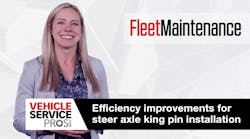When it comes to in-cab heating solutions for commercial vehicles, the benefits are numerous. While cabin comfort for the driver is evident, these systems help limit idle time and save fuel when the vehicle is parked, as an alternative to running the vehicle’s engine to keep warm. While there is already a limited amount of maintenance necessary for these systems, additional improvements and diagnostic processes continue to help improve these products. Representatives from Eberspaecher Climate Control Systems talked with Fleet Maintenance about trends with servicing and diagnosing in-cab heating systems.
Transcription of interview:
Erica Schueller, Fleet Maintenance: Hello and welcome to VSP News: Uptime Update. I am your host Erica Schueller, Editor-in-Chief of Fleet Maintenance magazine, covering all maintenance, all vehicle classes, all management, all the time.
When it comes to in-cab heating solutions for commercial vehicles, the benefits are numerous. While cabin comfort for the driver is evident, these systems also help limit idle time and save fuel when the vehicle is parked, as an alternative to running the vehicle’s engine to keep warm.
While there is already a limited amount of maintenance necessary for these systems, additional improvements and diagnostic processes continue to help make these products even more beneficial and easier to service.
John Dennehy, vice president of marketing, Eberspaecher Climate Control Systems, and Thomas Stencil, senior regional manager for North Central U.S., Eberspaecher Climate Control Systems, talked with Fleet Maintenance magazine about the trends with servicing and diagnosing in-cab heating systems.
We first discussed the current challenges technicians face when training and understanding heating systems in the vehicle.
John Dennehy, Eberspaecher Climate Control Systems: These products are very technically inclined with a lot of moving parts, and they’re typically installed in a storage compartments and engine compartments, which are typically hard to get at, so the first thing is getting at the units. Once you get through that stage, for the most part, if you’ve been trained on taking these heating systems apart, you’re pretty much good to go.
Thomas Stencil, Eberspaecher Climate Control Systems: In my opinion, it can be strange for the technician because they don’t work with them a lot. They need the resources to gather the information on how to repair the heater – the steps to understanding what the heater does and accessing the information on our website helps tremendously. Plus, being trained by Eberspaecher.
Schueller, Fleet Maintenance: When it comes to servicing and diagnosing in-cab heater systems, Stencil talks about the current diagnostic procedures and products available, and what we can expect in the not-too-distant future.
Stencil, Eberspaecher: Currently the latest and greatest tool that we have, called EZ Scan Diagnostic Tool, is a laptop based diagnostic tool. It directly hooks up to the heater itself and, in the future, I see that J1939 and CAN bus and cab controllers will have access to that information. But, currently, it’s an external item that uses computer-based software provided by Eberspaecher for gathering data and fault codes, and information to help the technician repair a heater. I think in the future you’ll have integration with J1939 and CAN bus, directly.
With the integration with the truck cab protocol J1939 and other LIN and CAN bus discussions, I think you’ll see in the future that, for example, our heater is currently under development with the CAN bus, so integration with the cab and chassis will make it easier for technicians to access information or relay information regarding any problems that may happen with the heater.
Schueller, Fleet Maintenance: To help ensure proper operation and longevity of the in-cab heater, Stencil has some suggestions on preventive maintenance practices to proactively avoid system issues.
Stencil, Eberspaecher: First of all, the simplest advice I can give you is to turn the heater on once per month – even in warm months – for 15 to 30 minutes. The reason you do that is to keep the fuel system primed, to keep the fuel system plunger internally moving so it doesn’t stick, and also like a self-cleaning oven, as we ingest warm air into the heater, it actually burns off the carbons.
If you do that, one you learn about the heater if it starts to have some maintenance issues, and then also every month, because its working, in October when you need the heater then the heater is working and it’s easier for the fleet – they have less maintenance costs, and it’s better for the heater and the customer.
Schueller, Fleet Maintenance: What continuing trends can we anticipate with regards to vehicle in-cab heating systems in the future? Dennehy and Stencil share more.
Dennehy, Eberspaecher: We see a trend moving to more electric, for sure, and I mentioned earlier we see diesel eventually going away. We have another division at Eberspaecher called Catem, and those guys are manufacturing what we call PTC heaters, which stands for power temperature coefficient. They’re all-electric, and I believe we’ll see a strong OEM buying trend going on with those heaters, as we wean out of diesel over the next 25 to 50 years.
Stencil, Eberspaecher: I think what you’ll find is that there will be major improvements with the product line to extend the life of the heater, reduce maintenance on the heater designed for longevity for fleet turnover of – let’s say approximately four years – when the truck gets traded.
Our objective is to reduce the amount of issues that a customer would have including items like brushless blower motors and automatic altitude compensation which is relevant to the longevity of the heaters.
Product improvements, and then maybe integration with the J1939 protocol, so it makes it easier for technicians to use one tool to talk to the whole truck, rather than just the heater.
Schueller, Fleet Maintenance: If you’d like to learn more about heating systems for commercial vehicles – both for in-cab solutions and engine coolant heaters – check out the link to a story from Fleet Maintenance magazine below.
That’s it for this week’s episode! As always, thank you for tuning in to VSP News Uptime Update, I’m your host Erica Schueller.
Until our next broadcast, keep up with this, and other industry topics, by visiting us online at VehicleServicePros.com.
Learn more about heating systems for commercial vehicles for both in-cab solutions and engine coolant heaters.


